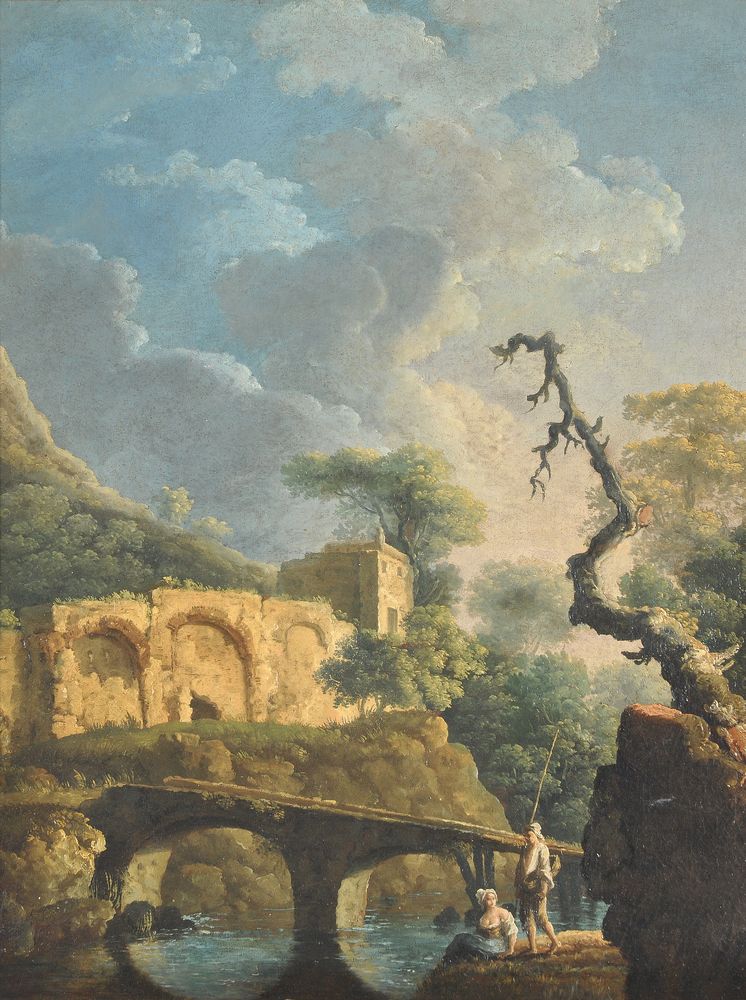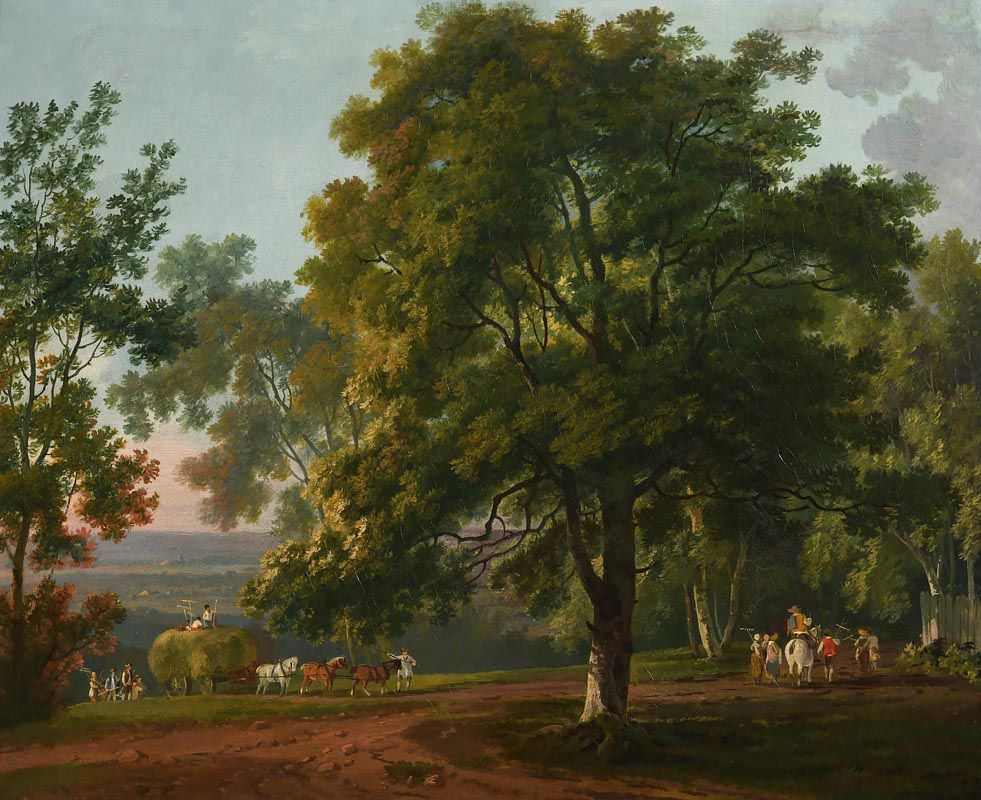Artist: George Barret (c.1728-1784) Title: A Landscape with Figures and the Ruins of Melrose Abbey, Roxburghshire Signature: signed 'G. Barret' lower centre right Medium: oil on canvas Size: 107 x 147cm (42.1 x 57.9in) Framed Size: 123 x 163.5cm (48.4 x 64.4in) Provenance: Private Collection; Christie's, London, 11th November 1994, lot 30; These Rooms, 14th April 2020 lot 32; Private Collection Exhibited: Gorry Gallery, Dublin, 'An Exhibition of 18th-21st Century Irish Paintings' 12th-31st October 2020 No.1(illustrated on p.2) a#morebtn { color: #de1d01; } a#morebtn:hover { cursor: pointer;} Dating from around 1770, this magnificent painting by George Barret shows the fifteenth-century ruins of Melrose Abbey, a medieval Cistercian monastery on the Scottish borders, beside the river Tweed. The main architectural features of the abbey, its east window and transepts, form the focal point o... Read more George Barret Lot 61 - 'A Landscape with Figures and the Ruins of Melrose Abbey, Roxburghshire' Estimate: €50,000 - €70,000 Dating from around 1770, this magnificent painting by George Barret shows the fifteenth-century ruins of Melrose Abbey, a medieval Cistercian monastery on the Scottish borders, beside the river Tweed. The main architectural features of the abbey, its east window and transepts, form the focal point of the composition. Through the east window can be glimpsed the presbytery and choir. In the left foreground, a family accompanied by a dog are picnicking in the shade of a tree. A boy in the group is proudly showing a fish he has caught in the nearby river. Scattered around the abbey precincts can be seen what appear to be low tables; these are gravestones, many of which survive, and the ruins as depicted by Barret are remarkably similar to those seen by visitors today. His painting, one of the earliest accurate views of the abbey, was painted around 1770 and commissioned by the Duke of Buccleuch. The choice of an Irish artist was appropriate, as the original abbey had been founded by St. Aidan of Lindisfarne, for monks from St. Columba's monastery on Iona. An early prior of Melrose, St. Cuthbert, later became prior of Lindisfarne. In the 12th century, the abbey was revived by Cistercian monks, but over the succeeding centuries the buildings were burned on several occasions during wars between England and Scotland. The abbey has long been recognised as an important historic site, and featured in Thomas Pennant's 1772 Tour in Scotland and Francis Grose's 1789 Antiquities of Scotland. Sir Walter Scott lived at Abbotsford, a few miles west of Melrose, and his 1803 poem The Lay of the Last Minstrel, celebrates the abbey and its history. In addition to poets such as Scott, and William Wordsworth, the ruins at Melrose have inspired visual artists, among them Thomas Girtin, John Varley, David Roberts and William Turner-Turner's depiction of the east window is inscribed with a (slightly inaccurate) quotation from Scott's poem: "who'er would see fair Melrose right/ must visit by the pale Moonlight". When painted by Barret, the central part of the nave was still being used as the parish church for Melrose. His painting highlights the elegant Gothic traceries of the abbey, the same traceries that would later would inspire Scott: "The moon on the east oriel shone/Through slender shafts of shapely stone". Barret's painting appears to be one of the earliest accurate views of the abbey, and confirms his status as a rising star in the eighteenth-century English art world. Having moved to London from Dublin, aided by his patron Edmund Burke, Barret was securing commissions from wealthy patrons, including Buccleuch. In or around 1769 he visited the duke's estate at Dalkeith near Edinburgh, and stopped off at Melrose Abbey along the way, to make sketches. The results of this trip to Scotland were exhibited at the inaugural exhibition of the Royal Academy in London the following year and included views of the duke's estate. Another pai
Artist: George Barret (c.1728-1784) Title: A Landscape with Figures and the Ruins of Melrose Abbey, Roxburghshire Signature: signed 'G. Barret' lower centre right Medium: oil on canvas Size: 107 x 147cm (42.1 x 57.9in) Framed Size: 123 x 163.5cm (48.4 x 64.4in) Provenance: Private Collection; Christie's, London, 11th November 1994, lot 30; These Rooms, 14th April 2020 lot 32; Private Collection Exhibited: Gorry Gallery, Dublin, 'An Exhibition of 18th-21st Century Irish Paintings' 12th-31st October 2020 No.1(illustrated on p.2) a#morebtn { color: #de1d01; } a#morebtn:hover { cursor: pointer;} Dating from around 1770, this magnificent painting by George Barret shows the fifteenth-century ruins of Melrose Abbey, a medieval Cistercian monastery on the Scottish borders, beside the river Tweed. The main architectural features of the abbey, its east window and transepts, form the focal point o... Read more George Barret Lot 61 - 'A Landscape with Figures and the Ruins of Melrose Abbey, Roxburghshire' Estimate: €50,000 - €70,000 Dating from around 1770, this magnificent painting by George Barret shows the fifteenth-century ruins of Melrose Abbey, a medieval Cistercian monastery on the Scottish borders, beside the river Tweed. The main architectural features of the abbey, its east window and transepts, form the focal point of the composition. Through the east window can be glimpsed the presbytery and choir. In the left foreground, a family accompanied by a dog are picnicking in the shade of a tree. A boy in the group is proudly showing a fish he has caught in the nearby river. Scattered around the abbey precincts can be seen what appear to be low tables; these are gravestones, many of which survive, and the ruins as depicted by Barret are remarkably similar to those seen by visitors today. His painting, one of the earliest accurate views of the abbey, was painted around 1770 and commissioned by the Duke of Buccleuch. The choice of an Irish artist was appropriate, as the original abbey had been founded by St. Aidan of Lindisfarne, for monks from St. Columba's monastery on Iona. An early prior of Melrose, St. Cuthbert, later became prior of Lindisfarne. In the 12th century, the abbey was revived by Cistercian monks, but over the succeeding centuries the buildings were burned on several occasions during wars between England and Scotland. The abbey has long been recognised as an important historic site, and featured in Thomas Pennant's 1772 Tour in Scotland and Francis Grose's 1789 Antiquities of Scotland. Sir Walter Scott lived at Abbotsford, a few miles west of Melrose, and his 1803 poem The Lay of the Last Minstrel, celebrates the abbey and its history. In addition to poets such as Scott, and William Wordsworth, the ruins at Melrose have inspired visual artists, among them Thomas Girtin, John Varley, David Roberts and William Turner-Turner's depiction of the east window is inscribed with a (slightly inaccurate) quotation from Scott's poem: "who'er would see fair Melrose right/ must visit by the pale Moonlight". When painted by Barret, the central part of the nave was still being used as the parish church for Melrose. His painting highlights the elegant Gothic traceries of the abbey, the same traceries that would later would inspire Scott: "The moon on the east oriel shone/Through slender shafts of shapely stone". Barret's painting appears to be one of the earliest accurate views of the abbey, and confirms his status as a rising star in the eighteenth-century English art world. Having moved to London from Dublin, aided by his patron Edmund Burke, Barret was securing commissions from wealthy patrons, including Buccleuch. In or around 1769 he visited the duke's estate at Dalkeith near Edinburgh, and stopped off at Melrose Abbey along the way, to make sketches. The results of this trip to Scotland were exhibited at the inaugural exhibition of the Royal Academy in London the following year and included views of the duke's estate. Another pai















Try LotSearch and its premium features for 7 days - without any costs!
Be notified automatically about new items in upcoming auctions.
Create an alert